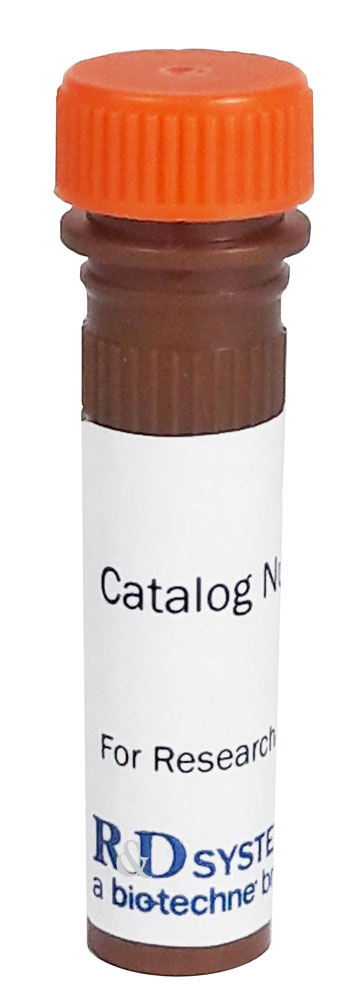Mouse L1CAM Alexa Fluor® 488-conjugated Antibody Summary
Applications
Please Note: Optimal dilutions should be determined by each laboratory for each application. General Protocols are available in the Technical Information section on our website.
Reconstitution Calculator
Preparation and Storage
Background: L1CAM
L1CAM, also known as Neural Cell Adhesion Molecule L1 (NCAM-L1) and CD171, is a 200-220 kDa type I transmembrane glycoprotein of the immunoglobulin superfamily and L1/neurofascin/NgCAM family (1, 2). L1CAM is expressed by neurons, especially by growing axons on their growth cones (2). Non-neuronal cells such as Schwann cells, astrocytes, epithelial cells, and cells of myelomonocytic and lymphoid origin also express L1CAM (2). Mature mouse L1CAM consists of a 1104 amino acid (aa) extracellular domain (ECD) with 6 Ig-like domains and 5 fibronectin type-III domains, a 23 aa transmembrane region, and a 114 aa cytoplasmic tail (3). Mouse L1CAM shares 88% aa sequence identity with human L1CAM. L1CAM is critical for neural development. Specifically, L1CAM plays a key role in neuronal cell migration, axon outgrowth, axon fasciculation, synaptogenesis, and myelination (4). L1CAM mediates homophilic cell-cell interaction but also binds heterophilically with Axonin-1, CD24, CD9, Neurocan and several Integrins (4). L1CAM can undergo membrane-proximal cleavage by ADAM10 and ADAM17, leading to the release of the soluble ECD and the generation of a membrane-bound stub (4). The soluble ECD can serve as a substrate for integrin-mediated cell adhesion, thereby stimulating cellular motility and cell migration (4). L1CAM also plays a role in the ontogeny of human tumors, and its expression is linked to poor prognosis (1). Overexpression promotes tumor cell invasion and motility, growth in nude mice, and tumor metastasis (1). Proteolytic processing by ADAM10 and presenilin/ gamma -secretase is essential for the nuclear signaling of L1CAM in human carcinoma cell lines (1). Defects in L1CAM are the cause of the neurological MASA/CRASH syndrome (5, 6).
- Riedle, S. et al. (2009) Biochem. J. 420:391.
- Kenwrick, S. and P. Doherty (1998) Bioessays 20:668.
- Crossin, K.L. and L.A. Krushel (2000) Dev. Dyn. 218:260.
- Maretzky, T. et al. (2005) Mol. Cell. Biol. 25:9040.
- Kamiguchi, H. et al. (1998) Mol. Cell Neurosci. 12:48.
- Striha, L. et al. (2000) J. Child Neurol. 15:239.
Product Datasheets
Product Specific Notices
This product is provided under an agreement between Life Technologies Corporation and R&D Systems, Inc, and the manufacture, use, sale or import of this product is subject to one or more US patents and corresponding non-US equivalents, owned by Life Technologies Corporation and its affiliates. The purchase of this product conveys to the buyer the non-transferable right to use the purchased amount of the product and components of the product only in research conducted by the buyer (whether the buyer is an academic or for-profit entity). The sale of this product is expressly conditioned on the buyer not using the product or its components (1) in manufacturing; (2) to provide a service, information, or data to an unaffiliated third party for payment; (3) for therapeutic, diagnostic or prophylactic purposes; (4) to resell, sell, or otherwise transfer this product or its components to any third party, or for any other commercial purpose. Life Technologies Corporation will not assert a claim against the buyer of the infringement of the above patents based on the manufacture, use or sale of a commercial product developed in research by the buyer in which this product or its components was employed, provided that neither this product nor any of its components was used in the manufacture of such product. For information on purchasing a license to this product for purposes other than research, contact Life Technologies Corporation, Cell Analysis Business Unit, Business Development, 29851 Willow Creek Road, Eugene, OR 97402, Tel: (541) 465-8300. Fax: (541) 335-0354.
FAQs
No product specific FAQs exist for this product, however you may
View all Antibody FAQsReviews for Mouse L1CAM Alexa Fluor® 488-conjugated Antibody
There are currently no reviews for this product. Be the first to review Mouse L1CAM Alexa Fluor® 488-conjugated Antibody and earn rewards!
Have you used Mouse L1CAM Alexa Fluor® 488-conjugated Antibody?
Submit a review and receive an Amazon gift card.
$25/€18/£15/$25CAN/¥75 Yuan/¥2500 Yen for a review with an image
$10/€7/£6/$10 CAD/¥70 Yuan/¥1110 Yen for a review without an image


